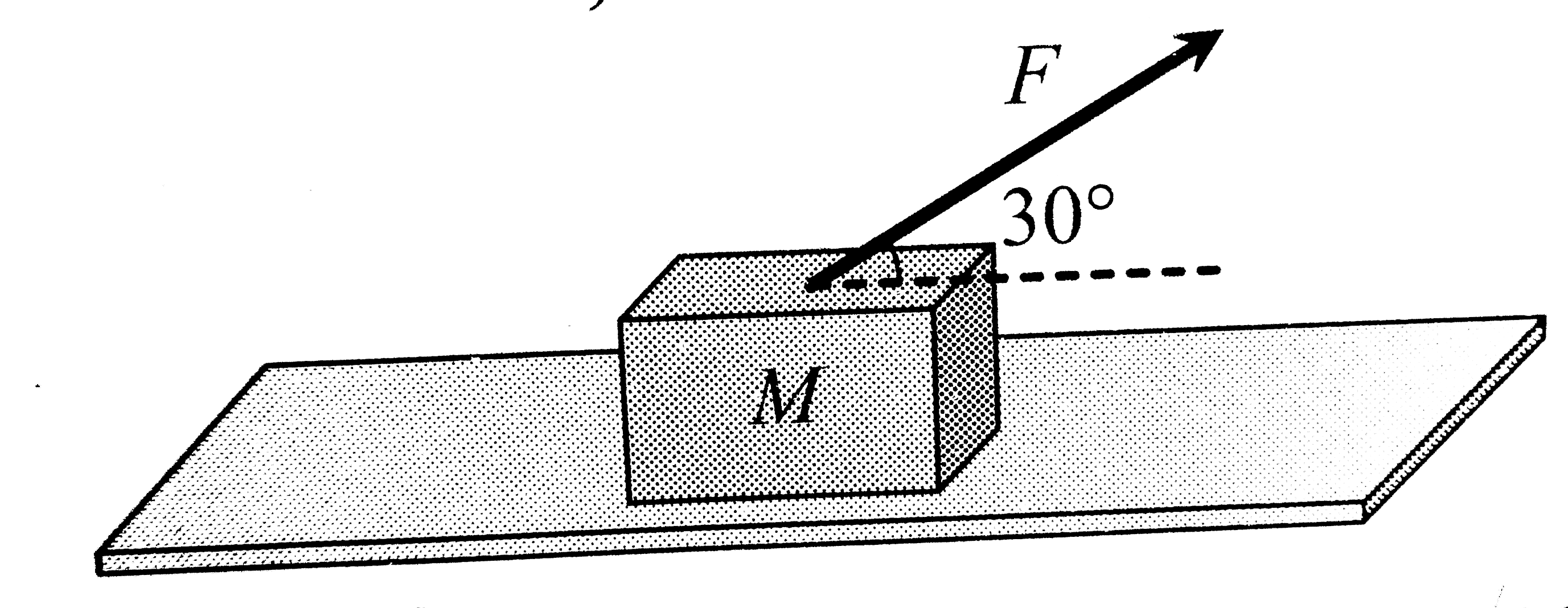A block of mass m=1kg moving on a horizontal surface with speed vi=2ms−1 enters a rough patch ranging from x0.10m→x=2.01m. The retarding force Fr on the block in this range ins inversely proportional to x over this range
Fr=−kxfor0.1<x<2.01m
=0 for <0.1m and x>2.01m where k=0.5J. What is the final K.E. and speed vf of the block as it crosses the patch?
To solve the problem, we will follow these steps:
Step 1: Understand the Problem
We have a block of mass m=1kg moving with an initial speed vi=2m/s. The block enters a rough patch where a retarding force Fr=−kx acts on it for 0.1<x<2.01 m. The value of k is given as 0.5J. We need to find the final kinetic energy and speed vf of the block as it crosses the patch.
Step 2: Calculate the Work Done by the Retarding Force
The work done by the retarding force can be calculated using the integral of the force over the distance:
W=∫x2x1Frdx
Where x1=0.1m and x2=2.01m.
Substituting the expression for Fr:
W=∫2.010.1−kxdx
Step 3: Evaluate the Integral
Since k is a constant, we can factor it out of the integral:
W=−k∫2.010.11xdx
The integral of 1x is lnx:
W=−k(lnx)2.010.1
Calculating the limits:
W=−k(ln(2.01)−ln(0.1))
Using the property of logarithms lna−lnb=lnab:
W=−kln(2.010.1)=−kln(20.1)
Step 4: Substitute the Value of k
Now substituting k=0.5J:
W=−0.5ln(20.1)
Calculating ln(20.1) (approximately 3):
W≈−0.5×3=−1.5J
Step 5: Relate Work Done to Change in Kinetic Energy
According to the work-energy theorem, the change in kinetic energy is equal to the work done:
ΔKE=W
The change in kinetic energy can also be expressed as:
ΔKE=KEf−KEi=12mv2f−12mv2i
Substituting the values:
ΔKE=12(1)v2f−12(1)(22)
This simplifies to:
ΔKE=12v2f−2
Setting this equal to the work done:
12v2f−2=−1.5
Step 6: Solve for Final Velocity
Rearranging gives:
12v2f=0.5
Multiplying both sides by 2:
v2f=1
Taking the square root:
vf=1m/s
Step 7: Calculate Final Kinetic Energy
Now, we can find the final kinetic energy:
KEf=12mv2f=12(1)(12)=0.5J
Final Answers
- Final Kinetic Energy KEf=0.5J
- Final Speed vf=1m/s
---
We have a block of mass m=1kg moving with an initial speed vi=2m/s. The block enters a rough patch where a retarding force Fr=−kx acts on it for 0.1<x<2.01 m. The value of k is given as 0.5J. We need to find the final kinetic energy and speed vf of the block as it crosses the patch.
The work done by the retarding force can be calculated using the integral of the force over the distance:
Since k is a constant, we can factor it out of the integral:
Now substituting k=0.5J:
According to the work-energy theorem, the change in kinetic energy is equal to the work done:
Rearranging gives:
Now, we can find the final kinetic energy:
- Final Kinetic Energy KEf=0.5J
- Final Speed vf=1m/s
Topper's Solved these Questions
- BOOK - PRADEEPCHAPTER - WORK, ENERGY AND POWEREXERCISE - Conceptual Problems27videos
WORK, ENERGY AND POWER
- BOOK - PRADEEPCHAPTER - WORK, ENERGY AND POWEREXERCISE - Very Short Anwer Question.54videos
WORK, ENERGY AND POWER
- BOOK - PRADEEPCHAPTER - WORK, ENERGY AND POWEREXERCISE - Curiosity questions2videos
WORK, ENERGY AND POWER
- BOOK - PRADEEPCHAPTER - THERMODYNAMICSEXERCISE - Assertion- Reason Type Questions19videos
THERMODYNAMICS
Similar Questions
A block of mass m=1kg moving on a horizontal surface with speed vi=2ms−1 enters a rough patch ranging from x0.10m→x=2.01m. The retarding force Fr on the block in this range ins inversely proportional to x over this range
Fr=−kxfor0.1<x<2.01m
=0 for <0.1m and x>2.01m where k=0.5J. What is the final K.E. and speed vf of the block as it crosses the patch?View SolutionA body of mass 2 kg moving on a horiontal surface with apeed vi=1ms−1 enters a rough patch ranging from x=0.5m to x=1.5m. If the body comes to rest after pussing the patch, then find the retarding force on the body.
View Solution
Knowledge Check
- Question 1 - Select One
A block of mass m=1kg moving on a horizontal surface with speed vi=2ms−1 enters a rough patch ranging from x0.10m→x=2.01m. The retarding force Fr on the block in this range ins inversely proportional to x over this range
Fr=−kxfor0.1<x<2.01m
=0 for <0.1m and x>2.01m where k=0.5J. What is the final K.E. and speed vf of the block as it crosses the patch?A2m−1B1m−1C3m−1D0.5m−1 - Question 2 - Select One
A block of mass 5kg is lying on a rough horizontal surface. The coefficient of static and kinetic friction are 0.3 and 0.1 and 10m/s−2. If a horizontal force of 50N is applied on the block, the frictional force is
A25NB5NC10NDZero - Question 3 - Select One
A block of mass m=5kg is resting on a rough horizontal surface for which the coefficient of friction is 0.2 . When a force F=40N is applied, the acceleration of the block will be (g=10m/s2) .
 A5.73m/sec2B8.0m/sec2C3.17m/sec2D10.0m/sec2
A5.73m/sec2B8.0m/sec2C3.17m/sec2D10.0m/sec2
A block of mass 2kg is sliding on a smooth surface. At t=0, its speed is v0=2m/s. At t=0, a time varying force starts acting on the block in the direction opposite to v0 if the speed of object is 38Nm/s at t=10s. Find the value of N
 View Solution
View SolutionA block of mass 10 kg , moving in x direction with a constant speed of 10ms−1, is subjected to a retarding force F=0.1xJ/m during its travel from x=20m to 30m. Its final KE will be
View SolutionA block of mass 10 kg, moving in x-direction with a constant speed of 10ms−1, is subjected to a retarding force F=0.1×J/m during its travel from x=20 m to 30 m. Its final KE will be
View SolutionA block of mass 10 kg, moving in x-direction with a constant speed of 10ms−1, is subjected to a retarding force F=0.1×J/m during its travel from x=20 m to 30 m. Its final KE will be
View SolutionA block of mass 20 kg is moving in x-direction with a constant speed of 10ms−1. It is subjected to a retarding force F=(−0.1x)N during its travel from x=20m to x=30m. Its final kinetic energy will be
View Solution

